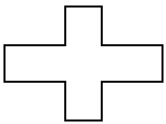This set of Aircraft Design Multiple Choice Questions & Answers (MCQs) focuses on “Tail Geometry and Arrangement”.
1. Typically tail provides ______
a) stability
b) control
c) stability and control
d) accelerating force
View Answer
Explanation: Typically tail is used to provide stability and control. Accelerating force will be provided from engines. One of the main function of the tail is to provide enough stability and controllability to make aircraft fly smoother at the time of any disturbance.
2. Which tail profile is shown in below diagram?

a) Cruciform tail
b) T – tail
c) H – tail
d) Conventional tail
View Answer
Explanation: Cruciform tail viewed from front will look like a ‘plus’ as shown in figure. T – tail will look like letter T and similarly H tail has shape of letter H.
3. Horizontal stabilizer is away from wing wake in T-tail configuration.
a) True
b) False
View Answer
Explanation: In T-tail configuration tail will look like letter T viewed from front. In T-tail horizontal stabilizer is at top of the vertical tail. This arrangement ensures that the horizontal stabilizer is away from wing wake.
4. Why dorsal fins are used?
a) To improve tail-effectiveness at high slide slip angle
b) To reduce tail-effectiveness at high slide slip angle
c) Similar to horizontal tail
d) Provides lift to fly
View Answer
Explanation: Dorsal fins are small attachments at the vertical tail. Dorsal fins are used for improving tail effectiveness at high slide slip angle. Dorsal fins are not similar to horizontal tail. Lift is primarily provided by wings.
5. Which control surface is primarily used for spin recovery?
a) Rudder
b) Elevator
c) Aileron
d) Flap
View Answer
Explanation: During spin aircrafts is not stable. Aircraft performs unstable yaw motion. For stabilizing such event adequate amount of rudder control is required. Flaps are used to increase lift and drag.
6. Elevator provides control for ______
a) pitching moment
b) yawing
c) roll
d) yaw-roll
View Answer
Explanation: Elevator is one of the primary control surfaces of an aircraft. The elevator is located at the horizontal tail. Elevator is responsible for pitching motion to provide required nose up or down moment.
7. Glider with span of 2m is flying at 10000ft. If aspect ratio of tail is 10 then, determine reference area of the tail.
a) 0.4m2
b) 0.4
c) 0.8
d) 0.8m2
View Answer
Explanation: Aspect ratio of tail = span square / area of tail
10 = 2*2 / area
Area = 4/10 = 0.4m2.
8. Which of the following is correct?
a) Tail sweep is generally more than wing sweep
b) Tail sweep is generally same as wing sweep
c) Tail sweep is always ten times of wing sweep
d) Tail sweep is generally less than wing sweep
View Answer
Explanation: Tail sweep is the sweep angle provided to tail. In general, tail sweep is more than wing sweep. Higher sweep at tail than wing sweep will increase critical mach number of the tail. Hence, it will delay shock formation at tail.
9. Typically, high speed aircrafts have thinner tail as compared to wing thickness.
a) True
b) False
View Answer
Explanation: Thickness ratio directly affects the critical mach number. At high speed it is one of the requirements to have higher values of critical mach number. To do so thin airfoil are used. Hence, to increase critical mach number tail is typically 10-12% thinner than the wing.
10. Which of the following is not part of tail?
a) Aileron
b) Rudder
c) Elevator
d) Horizontal stabilizer
View Answer
Explanation: Aileron is part of the wing. Rudder is part of vertical tail. Elevator is part of the horizontal tail. Horizontal tail is also called Horizontal stabilizer.
11. The inverted V-tail is used to ______
a) to reduce adverse yaw-roll
b) to provide adverse yaw-roll
c) to increase lift
d) to increase thrust
View Answer
Explanation: Inverted V tail arrangement is used to prevent the adverse yaw roll motion. Lift can be increased by flaps. Thrust is increased by an engine.
12. Determine the corrections or otherwise of the following assertion [A] and reason [R]:
Assertion [A]: Most of the tails are using symmetric airfoils.
Reason[R]: Tail control has two primary control surface.
a) Both [A] and [R] are true and [R] is the correct reason for [A]
b) Both [A] and [R] are true but [R] is not the correct reason for [A]
c) [A] is true but [R] is false
d) [A] is false but [R] is true
View Answer
Explanation: Tail control has two control surface as primary control surface namely elevator and rudder. Tail has main function of providing stability and control. Hence, it should not produce lift at zero angle like wings otherwise it will affect the stability of the aircraft. Hence, [A] and [R] both true but [R] is not correct reason for given [A].
13. What is the use of V type tail?
a) To reduce wetted area
b) To increase wetted area
c) To prevent adverse yaw roll
d) To produce thrust
View Answer
Explanation: V tail arrangement is used to combine horizontal and vertical tail. It combines in such way that the wetted area reduces. However, it generates adverse yaw roll motion. To prevent such effect inverted V tail can be used.
Sanfoundry Global Education & Learning Series – Aircraft Design.
To practice all areas of Aircraft Design, here is complete set of 1000+ Multiple Choice Questions and Answers.
If you find a mistake in question / option / answer, kindly take a screenshot and email to [email protected]
- Check Aerospace Engineering Books
- Check Aircraft Design Books
- Apply for Aerospace Engineering Internship
- Practice Aeronautical Engineering MCQs
- Practice Aerospace Engineering MCQs
